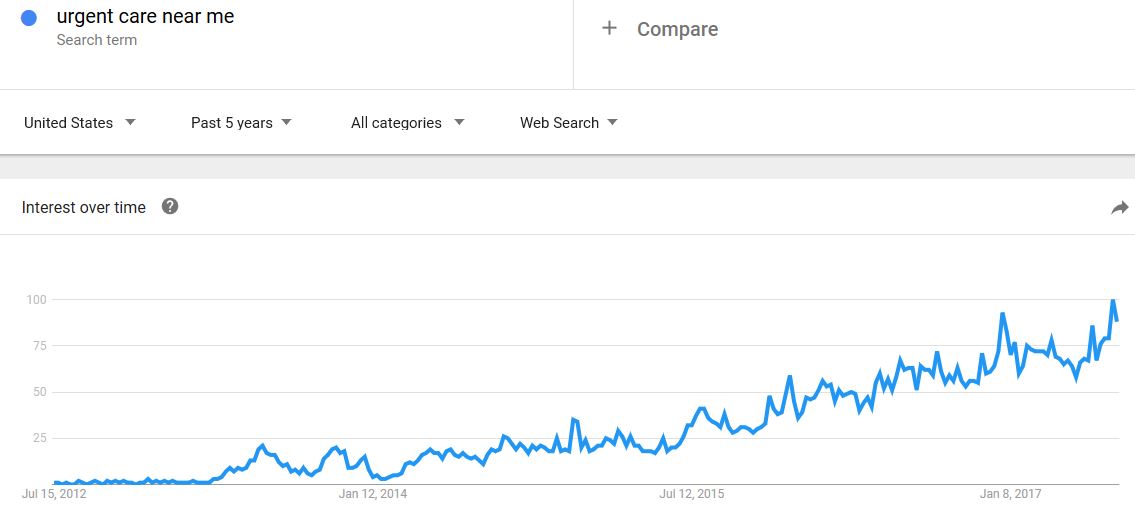Demographic, market, and technology trends make digital transformation critical to the future of healthcare.
Smartphones are ubiquitous and provide instant information, often just a question away for Siri or Alexa. The average consumer is empowered through their mobile device in every other aspect of their life—from relationships, to banking, to routine purchases – except for both health plans and healthcare providers.
Digitally engaged patients prove to be far more satisfied with their health plan or network of providers and genuinely feel more in control of their health. Taking what was a printed physician directory and making it available online isn’t digital engagement. It is time to rethink how technology can be leveraged in healthcare.
We are still operating in an environment where nearly one in five consumers does not know how to access care, and about the same percent for commercially insured consumers not knowing how to find a doctor covered by their plan. These concerns for providers and health plans are resolved with relatively simple digital innovations.
Merchant Medicine and J.D. Power conducted research on the biggest operators in the urgent care sector as a “front line” consumer healthcare angle, looking at integration of “searching for care” to “online check-in” to on-demand telemedicine options. Like many other areas of digitized life (remember using phone books?), once you start using the tools you cannot recall how things were done before them.
How Users Find Care Has Changed
One of the biggest changes subtly taking place in healthcare is in how people look for care. Primary care groups often don’t pay attention to this, and don’t provide access or service like the customer (e.g. boomers, gen X, millennial, etc.) may prefer. Ease of use and convenience are premium satisfaction drivers. Don’t assume patients will call an office first to see if they can get in; they simply will opt for the path of least resistance.
A Google Trends view on “urgent care near me” shows how dominate this mode is becoming – and still growing. The average consumer, in hopes of getting care on their terms, is able to quickly search for nearby locations, look at wait times, and either reserve a spot in their preferred center or start an online visit. It is also important to mention being influenced by online reviews – would any of us knowing take our families to get care at a one-star center? The shift over the last five years isn’t an early adopters fluke – we had one client share they hit 25% of visits via online check-in after one month of implementation. These are people who would have previously called a doctor’s office to ask for an appointment – and the use of location-based care search continues to grow.
Source: https://trends.google.com/trends/explore?date=today%205y&geo=US&q=urgent%20care %20near%20me Google’s description: “numbers represent search interest relative to the highest point on the chart for the given region and time. A value of 100 is the peak popularity for the term. A value of 50 means that the term is half as popular. Likewise a score of 0 means the term was less than 1% as popular as the peak.”
Your Apps Really Aren’t That Useful
Note to health plans, health systems, and corporate operators; no one wants to download your app. With a few exceptions for integrated delivery systems (e.g Kaiser Permanente), the low download rates speak for themselves. Downloads are often followed by uninstalls. Common sense dictates keeping it simple with an eye to the lowest common denominator: use text messaging if possible. The time for sophisticated high tech solutions is not “customer centric” when the patient is sick or parents are dealing with the chaos of a sick child in the house.
Simply stated, today’s consumer is using a smart phone with GPS, a feature that became widely popular about five years ago, so health organizations have no excuse when it comes to ignoring ways that could drastically improve their care delivery. Research on actual health plan app downloads from last summer is corroborated in JD Power’s annual commercial member study with about 5% of members reporting having downloaded their plan’s app:
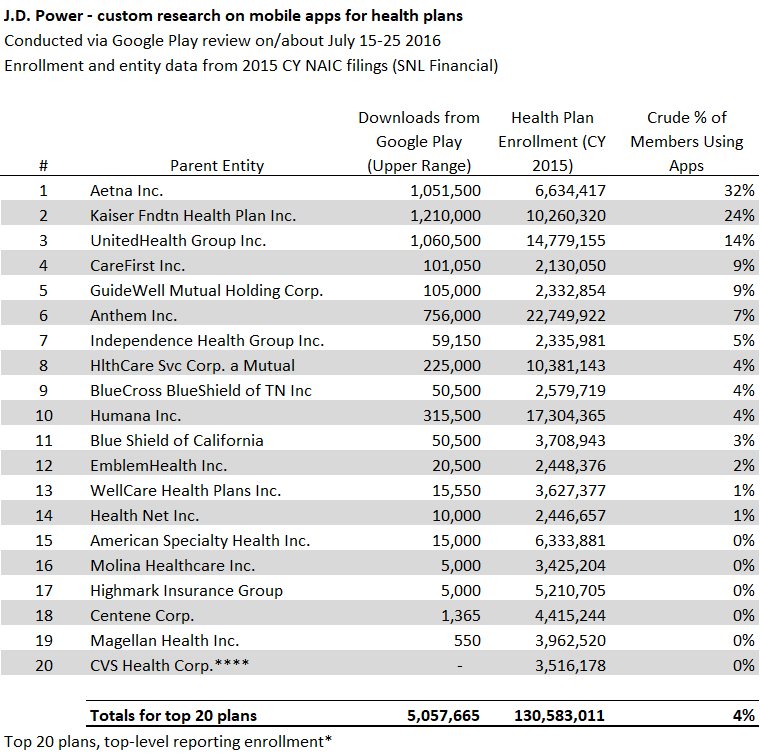
Even when a health plan can get their members to download the app, people aren’t using it. On average, members report less than 1 interaction made on a health plan mobile app in the past 12 months. This number has been consistently low over the past 4 years.
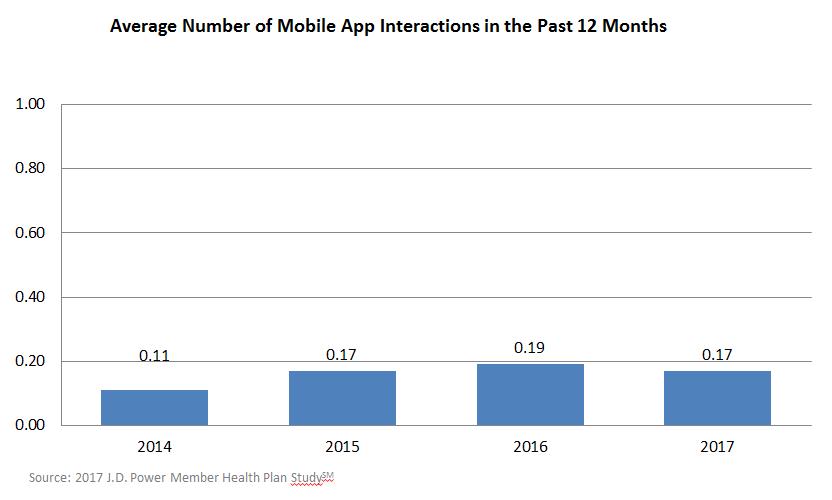
The more sophisticated, larger urgent care operators are a good measure for consideration – they know how to serve the 25-55 age range, dual income, commercially insured families. They have (mostly) built mobile-optimized websites with the ability to find care with few clicks.
Once these organizations build loyalty through the consumer experience, with the target buyers being largely on the hook for high deductibles, the operators could expect year after year of repeat visits. As contrasted with not-easy-to-use out-patient and physician offices. These walk-in operations cost a fraction of an emergency department visit, and the inconvenience of trying to fit in appointments or waiting for hours makes this a straightforward value proposition.
J.D. Power studies are clear that health plans must align to their physician networks, because the consumer/member/patient aligns there. For payors and firms providing digital solutions, aligning with the largest care access points will have the greatest impact on steerage, empowerment, and ultimately the overall health and well-being of the population being served.
Marketing Your Technological Investment: Analyzing Service Visibility
Trying to answer the question of “how do consumers use technology to find care”, we conducted February-March 2017 research on Merchant Medicine’s top 20 private and health system affiliated urgent care ranking, and asked the following:
• Does the landing page allow for check-in or scheduling? (e.g. not navigate through lots of pages)
• Does the landing page enable virtual care? (e.g. start a telemedicine visit right there)
• Does the landing page show wait times? (e.g. how long for ED, UC, etc.)
• For health systems, does the landing page have a highly visible link to urgent care or retail clinic services? (do they promote their consumer-oriented service lines)
The following tables rank these operators on the number of locations and survey results. If these consumer-driven features are not displayed on the landing page, they were not counted due to lack of visibility. This simulates the average consumer who will not go further than a few clicks from the homepage when looking for the information or service they want.
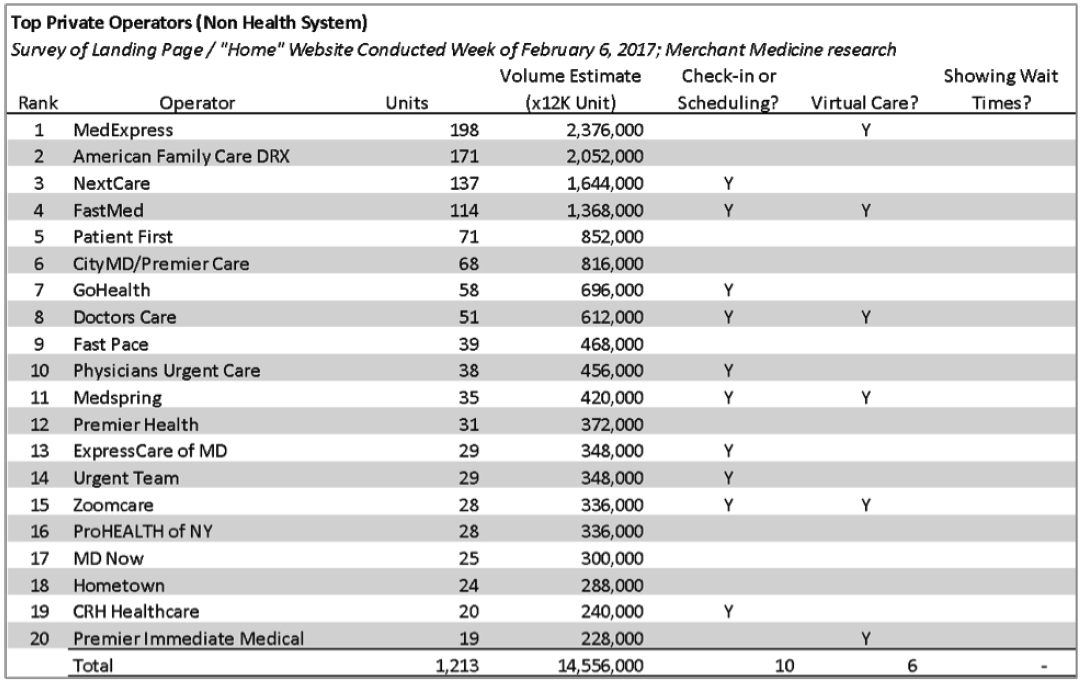
These operators are not a homogenous group, and only half were noted with online check-in; no wait times displayed on landing. (Side note; so often healthcare websites are built for the organization chart, and not the reason to exist – the patient/customer.) Several had virtual care options. Several are owned by large payers; some are joint venture operators with health system, and the rest are privately held. Some have freestanding centers and others are in strip malls. One thing they share: a focus on unit-level volume (patient) growth. The technology is an enabler to drive higher volume as compared to hospitals and less sophisticated operators.
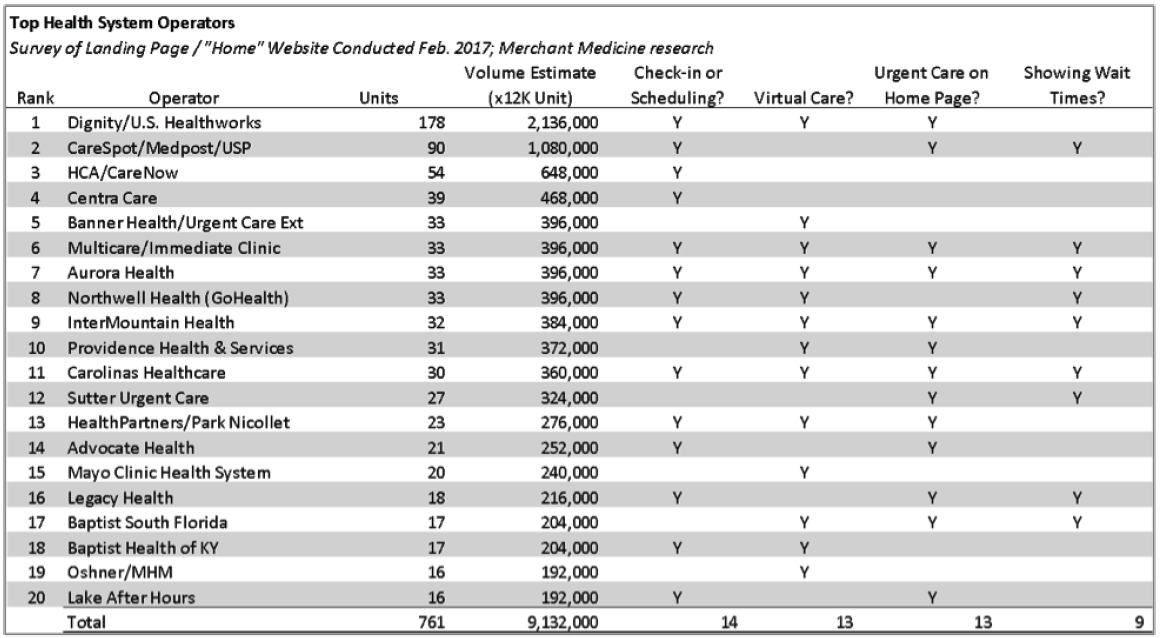
Among the largest hospital-affiliated operators, 14 of the 20 had online check-in or scheduling, 13 had virtual care, 13 had direct urgent care links, and 9 listed wait times online.
Like the private operators, they are a mixed bag. Some are more occupational health, some are pure urgent care, some in malls and some freestanding. Of the top 10, 5 are recent acquisitions by a system of a large chain in order to gain strategic leverage in their markets. They were quality operators to begin with, and largely graft that innovative spark into their health system owners.
Is the scheduling or check-in functionality perfect? No, but it gives the consumer control and care options. Do any of the operators have wait time issues? Yes, who doesn’t at some point; but the consumer can see the reality of it and make a decision. Deciding to accept the wait automatically lowers the frustration level as expectations are set in reality. It raises the bar. Anecdotally, the virtual visit volumes are low despite the hype, but it rounds out the instant access question.
Not to give the health plans a pass, we also surveyed their sites, with member ranking pulled from statutory insurance filings:
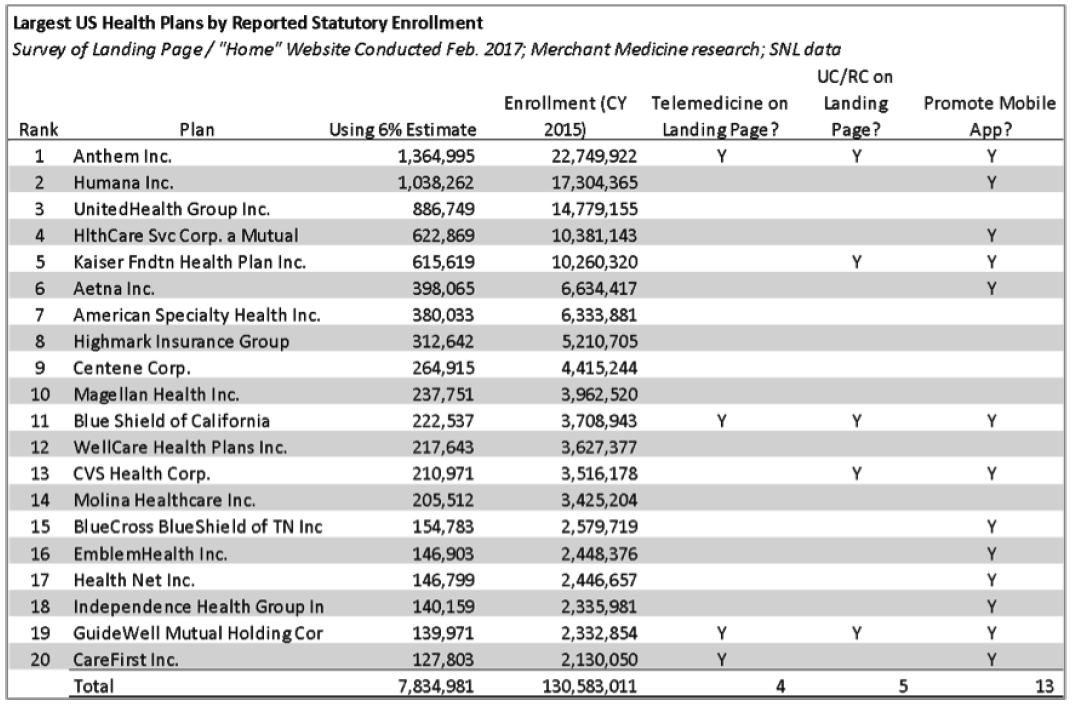
Only 4 of the 20 had an immediate telemedicine link; 5 had urgent care or retail clinic options; 13 of the 20 were promoting their mobile app. We suspect many have facility search and telemedicine options, but it is buried somewhere. Some of the apps have a picture of the insurance card and not a lot else; why not cut out the extra steps?
Kaiser Permanente had the most intuitive and comprehensive mobile app, which linked to patient charts, provided prescription information, clinic locations, and cost details. It is a competitive advantage to be able to integrate what the consumer is looking for. Recently, one executive from an integrated delivery system with numerous urgent care centers mentioned their consumer-facing technology integration; turns out there were several different apps to download (with different logos?). Leveraging technology for non-integrated delivery systems should serve as a virtual type of vertical integration.
Payers have great potential to impact the private operators and health systems via steerage – but first they need to be the go-to from a consumer technology perspective. Mentioning that virtual care is an option and then downloading a generic app from some vendor affiliate not known to the consumer is a fail point.
Interestingly, a large private equity firm recently acquired positions in a leading online check-in technology firm (via portfolio firm), a leading urgent care-focused electronic medical record system firm, and a large chain of urgent care centers.1
The technology isn’t the issue, it is the decision makers at these organizations. Larger private operators (including recently acquired by health systems as distinct brands) are the furthest ahead, followed by systems, and then plans.
The Results Are In: Consumers Want to be Involved in Their Health And You Can Help
J.D. Power research has shown that health outcomes are intrinsically linked to consumer engagement, with digitally engaged health plan members having a more positive perception of their health because they are empowered to manage their health independently.
Looking at consumer statistics, health plans have struggled forming a meaningful connection with their service and digital means. Just 5% of members downloaded their health plan’s mobile app last year, which up one percentage point from the prior year.
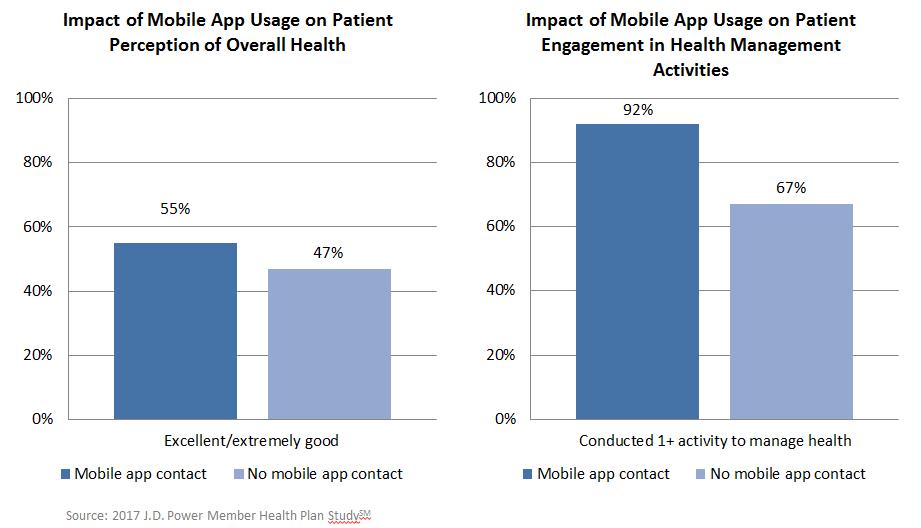
When services are fully advertised and important information is easily accessible, operators are better able to attract patients and educate them on how to be more in control of their health. The expression “simple is hard” is never truer than with technology.
The best technology is easy to use and hides complexity from the end user. When customers see it for the first time it changes their behavior going forward. Those that have the functionality in place now need to drive that as a competitive strength through their operations and measure satisfaction levels. Highly satisfied customers create a feedback loop. Those late to the game may benefit from avoiding pitfalls, but it might also be too late to capture market.
As leaders go into fall board retreats and strategic planning, ask the hard questions about how your patients/members interact with your core operations on a day to day basis, and focus on simplicity. Not only should it improve overall satisfaction scores, improve operations and enhance internal productivity, it should create longer-term relationships with your patient/member base.
Contact us to learn more:
Valerie Monet
Senior Director, Practice Lead for Health Insurance at J.D. Power
http://www.jdpower.com/
Valerie.Monet@jdpa.com
Valerie Monet is a Senior Director and Practice Lead for Health Insurance at J.D. Power. She is responsible for North American syndicated, proprietary and consulting services provided for clients for the health plan industry. Ms. Monet has been with J.D. Power for over 10 years and has 20 years of business management and research experience in both the public and private sectors with a background across the insurance, healthcare and financial services. Ms. Monet earned BS and an MPA from Wayne State University.
Bernie Kuhn
Principal, Merchant Medicine LLC
http://www.merchantmedicine.com/
Bernie@MerchantMedicine.com
Bernie Kuhn is a Principal at management consulting firm Merchant Medicine, LLC. He was previously Senior Vice President for Corporate Development at UCI Medical Affiliates (Doctors Care) in South Carolina, and he held a dual role as VP at parent insurer BlueCross BlueShield of South Carolina (BCBSSC). Prior to BCBSSC, Mr. Kuhn was a Senior Manager in KPMG's management consulting group with experience across health care, insurance, pharmaceuticals, and retail clients. He is a member of the Healthcare Financial Management Association (HFMA) and the Urgent Care Association of America (UCAOA). Mr. Kuhn earned BA at Michigan State University and an MBA at the University of Florida.
1http://www.warburgpincus.com/industry/geography/us/
The views, opinions and positions expressed within these guest posts are those of the author alone and do not represent those of Becker's Hospital Review/Becker's Healthcare. The accuracy, completeness and validity of any statements made within this article are not guaranteed. We accept no liability for any errors, omissions or representations. The copyright of this content belongs to the author and any liability with regards to infringement of intellectual property rights remains with them.


